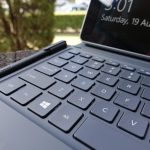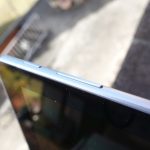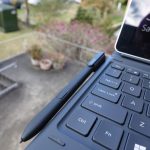Samsung disappointed more than a few at this year’s Mobile World Congress when it eschewed the event for its annual premium smartphone launch. Unlike years past, while Samsung was at the show, it didn’t announce smartphones. Instead, it announced a handful of new tablets, some of which ran Android, and perhaps a little surprisingly, the others ran Windows 10.
It is the latter variety of tablet we’re looking at today, in the form of Samsung’s 12-inch Galaxy Book which is a clear shot across the bow to the incumbent in the Windows 10 tablet space, Microsoft. This is a tablet clearly designed for those on the move, riding that fine line between ultra-portable laptop and tablet complete with fold-up keyboard and A-frame style stand.
We know it doesn’t run Android, but despite my initial skepticism, this is a tablet with some real bite, and so here’s our quick guide to the Galaxy Book from Samsung.
What is it?
Samsung’s 12-inch model of the Galaxy Book is a fully-featured Windows 10 system which weighs in at around 750 grams. It’s not quite the 13-inch screen which is more comfortable for laptopping, but the fact that it’s a Super AMOLED display (and not a LCD) means that it’s super comfortable to view anyway.
In the box is everything you need to get going; there’s the tablet itself, a keyboard which attaches easily to the bottom and which props up the display, Samsung’s S-Pen (in larger format), USB-C charger and cable. It’s not that different to the unboxing experience which we found with Dell’s XPS 13 2-in-1 earlier this year, though there aren’t any USB-C converters included in the box for those with USB-A accessories, such as an external keyboard, mouse or dock.
The model we’re reviewing is the top shelf model; it’s the larger 12-inch variant with S-AMOLED display (instead of the LCD in the 10.6-inch model), and while it’s available in a WiFi-only model, we’re reviewing the one which has 4G as well. This has made doing the review a lot easier, because it’s found a comfortable place in my bag for doing work on the go without the need for a WiFi hotspot or tethering from my mobile.
So, let’s talk key features. The display runs at 2,160 x 1,440 FHD resolution, and there’s an Intel Core i5 dual-core processor running at 3.1GHz. Our review model has 4GB RAM (though 8GB is available as an option) and 128GB storage (though 256GB is also available), and you can stick in a MicroSD card to increase that storage by up to 256GB on top of whatever’s on board.
There’s front and rear facing cameras, great for video calls and … well just video calls, though you could take photos with your great big tablet if you fancy looking like a tourist. Honestly though, that rear facing camera probably won’t get much use with the target audience.
Wireless connectivity is on par with your average mobile, with 4G compatibility with all Australian carriers, WiFi 802.11 a/b/g/n/ac, 2×2 MIMO and Bluetooth 4.1 LE. It even features a built in GPS which can be handy on occasion.
The battery is 5,070 mAh which doesn’t sound all that big, especially when you consider the 12-inch display that it has to power. Charging with the supplied USB-C charger is fairly quick, though, allowing you to keep using the Galaxy Book whenever, wherever.
The keyboard connects via pogo pins on the bottom, held in place by a solid magnetic connection. The keyboard cover kind of folds up behind the tablet itself to hold it up in a laptop-style orientation, and while it’s not quite as solid as Microsoft’s Surface kickstand, it works pretty well. It’s quite comfortable to use on the train on the lap, and equally comfortable to use on a desk.
Where does it excel?
As Windows 10 ultra-portables go, the Galaxy Book is neither the best nor the worst, though it certainly edges toward the better side of things. While it doesn’t have a Core i7 option which more higher-end devices have, the combination of the still-powerful-but-less-thirsty i5 and a decent battery size mean that the Galaxy Book does pretty well in its own right.
On the topic of performance, I didn’t manage to trip the Galaxy Book up, but I wasn’t exactly trying. Multi-tasking with a web browser and word processor sharing the screen was seamless (in fact, I’m using it like this now to write the review), and browsing with a dozen open tabs presented no issue, even if some included video playback or more demanding rendering.
The S-AMOLED display is just gorgeous — it’s the same technology used in Samsung’s high-end mobiles, and it seriously produces some of the most vivid, detailed imagery that I’ve seen on anything laptop-like. It makes the display on my Dell XPS 13 2-in-1 look positively archaic. Being an AMOLED, it an display true blacks, and this really does make Windows 10’s design pop. Beyond this, it has a great range of brightness suitable for use in all range of lighting environments, making it comfortable to use and read just about everywhere.
The detachable keyboard certainly wouldn’t be my preference; an attached keyboard is a lot more reliable, and Samsung’s keyboard is nothing special. It’s not unpleasant to use, though I find some keys require a bit more push than others, resulting in a few more typos than I’m normally used to. The touchpad, though, is quite accurate, as is the touch interface, making it — overall — a mostly happy, easy experience.
The S-Pen is an interesting inclusion, and feels almost an afterthought. While I understand the S-Pen inclusion with the Note range of larger smartphones, on a 2-in-1 it makes a little less sense. I personally didn’t really find a use for it, though if you’re taking notes in meetings or wanting to annotate PDFs (for example) it would be exceptionally useful. For everyone else, it probably won’t. Samsung does include some features from the mobile S-Pen interface though, including Air Command for bringing up quick features which make good use of the pen.
Built in audio is handled by stereo speakers which were more than loud enough to enjoy a bit of music while at work or to watch a YouTube video with a reasonable audio range. For more serious listening, though, you will definitely want some external speakers or headphones. The speakers just aren’t big enough to have real punch.
On the topic of battery life, from a full charge, the Galaxy Book dropped to 83% while writing the words for this review, and that’s over the space of an hour and a half. In my book, that’s not too bad. Oh, did I mention that I’ve got WiFi turned on (but disconnected) and I’m using the 4G modem in the background? Other reviews have benchmarked the battery life at around 6h30m for LTE web browsing, and that’s demanding usage, though if you were streaming Netflix, you could expect that time to drop a bit more.
All in all, 6 hours out of a 2-in-1 is nothing to sneeze at, and considering how quickly it charges back up, it’s more than enough to handle a commute, being charged at a desk, and the commute back home for those who just can’t give up working. It’s rated at 3 hours to charge fully from flat, though it will charge to 80% quite a bit faster than that.
What’s it not good at?
In all Ausdroid short-form reviews, we include this heading, but I found myself scratching my head to identify things with the Galaxy Book that I simply didn’t like. There were some annoyances, which I’ll now go into, but mostly, they were minor.
As touched on above, the keyboard was one of my least favourite areas. While it’s definitely serviceable, and not entirely unpleasant, the fact that it skips a few letters, and that some keys seemingly require ever so slightly more force to activate can become a little frustrating when doing a lot of typing. Having written this review on said keyboard, though, I would definitely recommend using an external, full-sized keyboard if you’re going to do lengthy writing. This keyboard just isn’t as ergonomic as you’d prefer for such a task.
I also didn’t especially enjoy the folding cover to prop the screen up. Samsung could definitely have gone for something a bit closer to the Surface Book style of design (with its rigid base and stand-free way of holding the screen up), something which would keep it ultra-portable but a little bit more friendly for use on the lap or on the go. It’s a small quibble, because overall, I didn’t really care, but it’s an area which Samsung could readily address without having to re-design the Galaxy Book itself.
Even the price is hard to argue with; at $1,799 outright, it’s a good deal cheaper than the starting price for some other 2-in-1s, but if you up the specs to the 8GB/256GB model, the pricing jumps to $2,299 which is exactly the same as Dell’s XPS 13 2-in-1 with similar specs, the difference being it has an (arguably) better keyboard and no annoying stand.
A more natural comparison is the Microsoft Surface, where the Core i5 4GB/128GB can be had for around $1500 — but at that price, you need to factor in an additional $200 or so for a Type Cover keyboard and an extra $95 if you want a pen. At that $1800 price point, the Surface and Galaxy Book are exactly on par, though there are a few more choices when it comes to Surface to get something a bit closer to your wants or needs; the Galaxy Book really only has choices of WiFi vs 4G models, two RAM/storage combinations, and two display sizes.
It’s a case of horses for courses really, but it’s good to know that — in terms of price, features, and ease of use — the Galaxy Book is right up there with the segment leaders.
Conclusion
If you’re after a highly portable Windows 10 machine, then something like the Samsung Galaxy Book is going to be right up your alley. It’s super thin — even with the keyboard cover attached — and with built in 4G capability, this is a truly use-anywhere device. There’s a few things that don’t make too much sense, though. The S-Pen truly feels like a little bit of an afterthought and it really isn’t necessary to make the most of out of the Galaxy Book.
While the folding keyboard cover keeps things nice and slim, I can’t help but wish that there was a rigid keyboard attachment ala the Surface Book, which would make this into a more versatile 2-in-1; the foldable display stand just doesn’t feel great, and it makes use on your lap a very precarious thing. When seated flat, with your knees at 90°, it works just fine. It does fairly well on a train commute, too. However, if you’re seated on a couch with your legs up, you can’t rest this on your legs, it’ll simply fall forward and attack you. I know, this seems like kind of edge-case stuff, and it is … there’s nothing manifestly wrong with the Galaxy Book. In fact, I love it. It’s just a few niggles around the edge.
Galaxy Book is available through Samsung Stores, online and in retailers starting at $1,099. The full price range is as follows:
| Model | Wi-Fi | OS | 4G | OS | |
|---|---|---|---|---|---|
| Samsung Galaxy Book 10.6-inch | 125GB | $1,099 | Win 10 Home | $1,299 | Win 10 Home |
| Samsung Galaxy Book 12-inch | 125GB | $1,599 | Win 10 Home | $1,799 | Win 10 Home |
| Samsung Galaxy Book 12-inch | 256GB | $1,899 | Win 10 Home | $2,299 | Win 10 Pro |
Disclosure Statement
Ausdroid has been permitted to keep the Galaxy Book for long term review.










